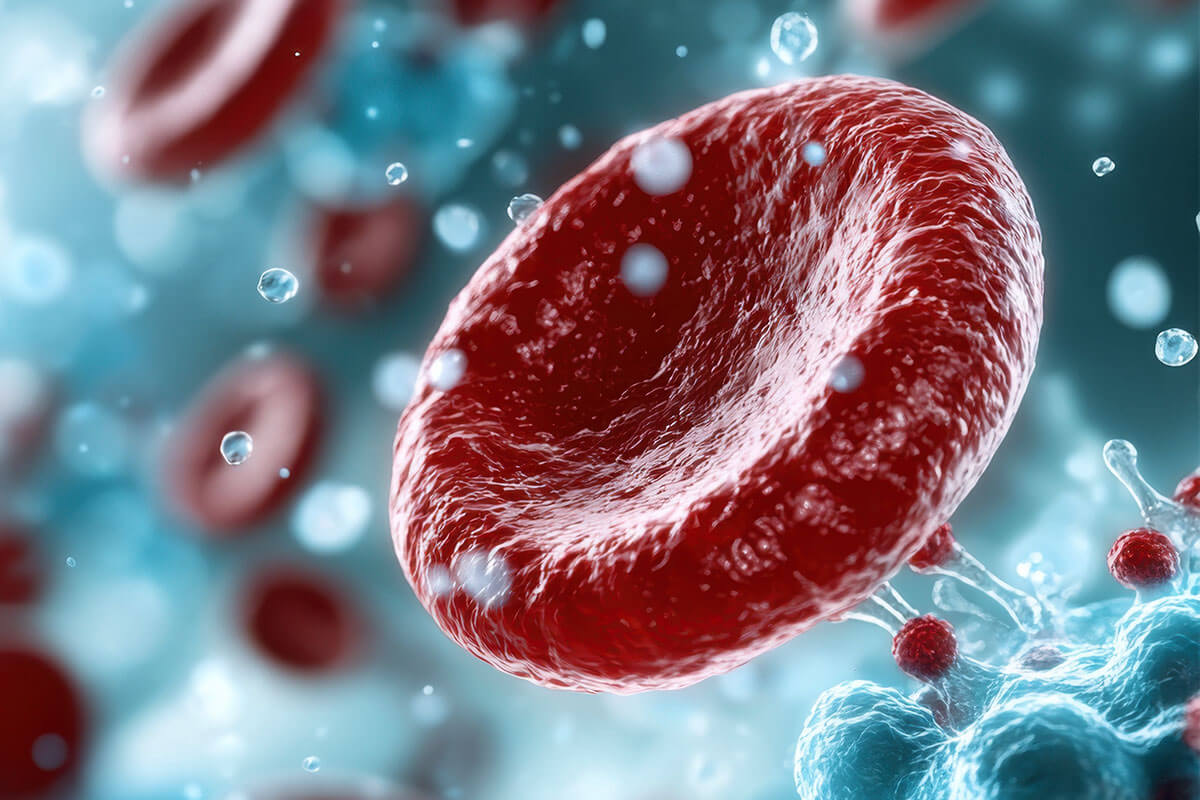Chronic disease = loss of energy in the cells
Our cells are true marvels. They may be microscopically small, but together they form our tissues, organs, and ultimately shape the entire body. Each organ has its own specialised function, carried out by dedicated cell types — over 200 in total. But as different as these cells are, they all have one thing in common: they need energy.
Each cell generates this energy in its own power stations — the mitochondria. If these power stations become damaged or weakened, the cell experiences an energy shortage and can no longer perform its function properly. Depending on the type of cell, this lack of energy can lead to a wide range of symptoms — from muscle or nerve pain to general discomfort or chronic illness. If the energy deficit persists, it can manifest as disease, potentially affecting any tissue, organ, or the entire body.

The body works as simply as this
Lack of regenerative capacity leads to illness
Humans naturally fluctuate between states of health and illness. To prevent every injury or strain from developing into disease, the body relies on its own self-healing programme: the regeneration and renewal of its cells. The fuel for this process is a small molecule called ATP (adenosine triphosphate). It acts as the cell’s energy carrier and is both produced and consumed in large quantities every second by the cell’s numerous power stations — the mitochondria.
Alongside the maintenance of many bodily functions, this energy allows cells to restore the original function of damaged or weakened cells. If our cells have enough ATP, we are in optimal health. But this ideal state is rarely experienced today. The strains of modern life have become too great. More and more energy is needed to repair cell function — overburdening the mitochondria. The regenerative capacity of our cells decreases.
Whether this reduced regeneration shows up as osteoarthritis, rheumatism, or osteoporosis, modern cellular medicine recognises that a lack of energy in the cells is both a cause and a risk factor. The health of our mitochondria plays a major role not only in the development of illness, but also in how it progresses. If we can restore sufficient ATP levels in our cells, self-healing processes can be reactivated — and illness can be overcome.
Kleinsche Fields in science:
Kleinsche Fields have a particular effect on mitochondria
The role of mitochondria as the source of life within our cells is now well recognised. Accordingly, scientific interest in how to enhance their performance continues to grow. A leading expert in mitochondrial research, Prof. Dr Brigitte König, has shown that the magnetic field technology of Kleinsche Fields can significantly improve mitochondrial function — and with it, cellular efficiency.
Prof. Dr. König comments:
» It is now well known in conventional medicine, and supported by high-ranking scientific publications, that malfunctioning mitochondria are responsible for numerous diseases. These include Alzheimer’s and Parkinson’s, as well as cardiovascular diseases, arteriosclerosis, circulatory disorders, diabetes mellitus, migraines, and more. So-called lifestyle diseases of modern society such as metabolic syndrome (including high blood pressure, obesity, altered blood lipid levels, and insulin resistance), polyneuropathy, sleep disorders and chronic pain are also linked to mitochondrial dysfunction. And because Kleinsche Fields positively influence mitochondrial function, they may also have a beneficial effect on all of these conditions.«
Rechtlicher Hinweis: Dieses Interview nimmt Bezug auf die Ergebnisse der Kleinsche Felder Pilotstudie¹. Um rechtlich allgemeine Wirkaussagen zu jeder einzelnen Erkrankung treffen zu dürfen, bedarf es weiterer großer Studien, um die jeweils rechtlich erforderliche Evidenz darzulegen. Wir sind überzeugt diese erweiterten Studienergebnisse in der geforderten sehr großen Form künftig eindrucksvoll erbringen zu können.

The Areas of BioRelax Research
Sleep the cells strong!
Kleinsche Fields - Masters of Regeneration
If you want to activate your self-healing processes, you need to sleep well.More than 90% of our regeneration takes place at night — but only if the conditions are right. Our cells must have enough energy for the necessary repair processes in order for the body to make the most of its many hours of sleep.
As nature intended, the body is capable of repairing itself every night — beginning with every single cell and extending to each organ. The BioRelax sleeping mat supports the cells' energy metabolism and acts like a natural recharging station, helping the night once again become an active recovery phase. This allows the cells to "refuel" with energy — every night.
The natural magnetic fields work entirely without electricity or batteries and produce no electrosmog, which could otherwise interfere with the cells' healing process. The gentle mode of action, along with the simple and safe application of the BioRelax sleeping mat, is what makes it so effective and widely appreciated. Once placed in bed, it supports the body’s regeneration across a large area — night after night. This creates the ideal conditions for the body to repair and regenerate itself.

Our product recommendations for you
FAQ
Most health concerns and conditions can be broadly classified as either whole-body or localised complaints. However, on closer inspection, many localised issues are also linked to broader body systems and therefore cannot be considered purely isolated problems. Whole-body complaints: If you are already familiar with Kleinsche Fields, you'll know that what matters is how much of the body’s surface area is exposed to the fields (effective area), and how long they can act on that area. For whole-body complaints such as those affecting the nervous system, sleep, or circulation, localised application is generally not sufficient. The BioRelax sleeping mat is ideal for these cases, as it delivers the benefits across the entire body for many hours during the night.
Localised complaints: [Missing content – please provide the section you wish to include here.] Is it sufficient to treat just one area of the body with Kleinsche Fields? This depends on the nature of the complaint. For systemic issues, a localised approach may not provide sufficient coverage or exposure time. We recommend following the “area and time” principle — the greater the area exposed to Kleinsche Fields and the longer the application, the more comprehensive the effect.
1. Reiter, Russel J., Tan, Dun Xian, Galano, Annia: Melatonin: exceeding expectations, Physiology (Bethesda) 2014, 29(5):235-33, DOI: 10.1152/physiol.00011.2014.
2. Xie, Lulu et al.: Sleep Drives Metabolite Clearance from the Adult Brain, Science 2013, Vol 342, Issue 6156, pp. 373-377, DOI: 10.1126/science.1241224.
3. Axelsson, John et al.: Sleepiness as motivation: a potential mechanism for how sleep deprivation affects behavior, Sleep 2020, Vol 43, Issue 6, DOI: 10.1093/sleep/zsz291.
4. Nissen, Christoph et al.: Sleep is more than rest for plasticity in the human cortex, Sleep 2021, Vol 44, Issue 3, DOI: 10.1093/sleep/zsaa216.
5. Spaeth, Andrea M., Dinges, David F., Goel, Namni: Effects of Experimental Sleep Restriction on Weight Gain, Caloric Intake, and Meal Timing in Healthy Adults, Sleep 2013, 1;36(7):981-990, DOI: 10.5665/sleep.2792.
6. Rihm, J. et.al.: Sleep Depreivation Selectively Upregulates an Amygdala-Hypothalamic Circuit Involved in Food Reward, The Journal of Neuroscience 2019, pp. 888 – 899.
7. Yu, Xiao et al.: A specific circuit in the midbrain detects stress and induces restorative sleep, Science 2022, Vol 377, Issue 6601, pp. 63-72, DOI: 10.1126/science.abn0853.
8. König, Brigitte: Einfluss von Klein`sche Felder Magnetstreifen auf Mitochondrienfunktionen. Voruntersuchung mit differenzierten THP-1-Zellen, Magdeburg, 2014.
9. König, Brigitte: Einfluss von Klein`sche Felder Magnetstreifen auf Mitochondrienfunktionen. Eine in-vitro Pilotstudie, Magdeburg, 2014.
10. König, Brigitte: Eine in-vivo/ex-vivo/in-vitro Pilotstudie–Beeinflussung von klinisch-chemischen Parametern und von Mitochondrienfunktionen peripherer Blutleukozyten (PBMC) durch Kleinsche Felder Magnetstreifen, Otto-von-Guericke-Universität Magdeburg, Germany, 2014.
11. Heisterkamp, Jonas: Beeinflussung der mitochondrialen Bioenergetik durch permanente polymorphe Magnetfelder, Otto-von-Guericke-Universität Magdeburg, Germany, 2017, (unveröffentlichte Bachelorarbeit).
12 Meyer, Ralf und Rinne, Jörg: Pilotstudie Kleinsche Felder. Anwendungsbeobachtung zur BioRelax Kleinsche Felder Schlafmatte, Riedstadt, 2024


































